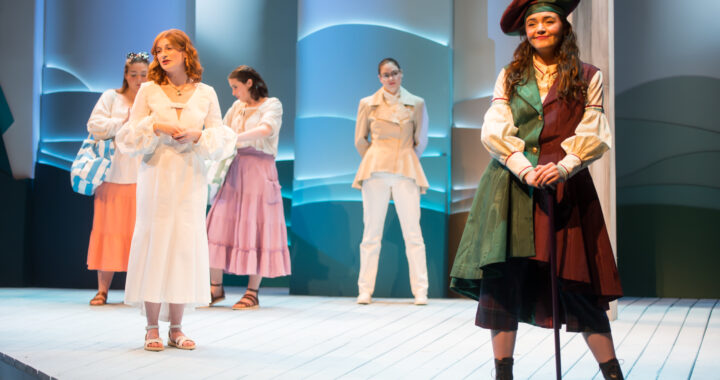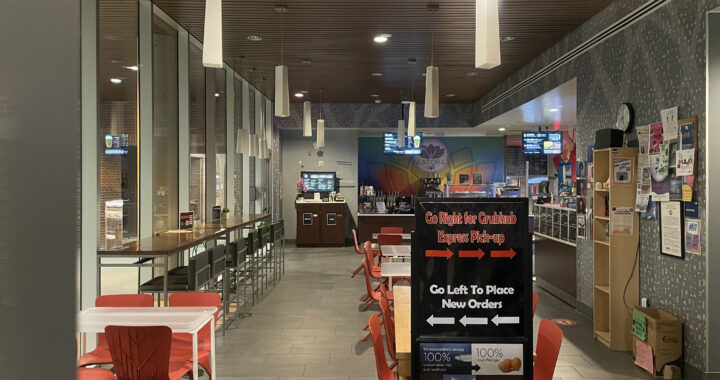Art Faculty Show True Colors
4 min readBY TIFFANY DOUGLASS
After astounding the University with her Pulitzer Prize award last year, world-renowned poet and professor Claudia Emerson continues to influence UMW’s academic community. She has always had a big impact on her students, but now she is providing inspiration for faculty members as well.
Sculpture professor Carole Garmon recently collaborated with Emerson on a 24-panel wall piece inspired by one of Emerson’s poems, “Sewing Bird: Outside My Window.” The panels were created with the help from views from Garmon’s living room window along with patterns of bed linens and references to the poem integrated as sewing clamps shaped like birds. Garmon used eight layers of plaster to portray a calm horizon with light pastel cloud appliqués in the series.
“Sewing Bird” is Garmon’s contribution to the Studio Art Faculty Exhibition which opened last Thursday evening in duPont Gallery. In celebration of UMW’s Centennial Celebrations, the gallery will be open to students for free every Monday, Wednesday and Friday from 10 a.m. to 4 p.m., and weekends 1 p.m. to 4 p.m. until October 21.
The collaboration between Garmon and Emerson began when the two professors previously attended each others’ classes in order to expand their knowledge of creative writing and 3D art, respectively. Fortunately, they found their teaching styles to be similar as one uses words, while the other uses art. Although Garmon has said she has found inspiration in Emerson’s poetry, she is happily “secure in my field with my own visual vocabulary.”
The exhibition also features work from art teachers Lorene Nickel, Joseph Detwiler, Joseph Di Bella, and Steve Griffin.
Among the sculptures, paintings, and portraits, it was clear that these artists were all in their element; sharing their passion with people who appreciate the hard work they have accomplished.
Jesse Kopp, a junior in Garmon’s Video Art class who attended the opening, said he was excited to see his teacher’s work on display. “This is such a great opportunity to see first hand the concepts that we are studying in class as well as a good time to ask intimate questions about their craft,” he said.
Lorene Nickel, a ceramics professor since 1981, collaborated with husband Joseph Detwiler, who frequently teaches courses at the university as an adjunct professor and is also a friendly face to Melcher’s studios. The middle of the gallery displays a progression of Nickel’s ceramic designs: foreign settings made of stoneware and porcelain. With an impressive professional background including a plethora of textile awards, Nickel combines unique, earthy tones juxtaposed with miniature yet vibrant sculptures.
“Context and position are constant themes in these most recent words, as many of the forms seem just slightly immune to gravity,” Nickel says in the exhibition catalogue.
Among the Exhibition pieces, Joseph Di Bella, a 30-year faculty member, covers the back wall with fifty portraits of fallen soldiers from the war in Iraq. At first glance, each face appears to be similar: the typical military crew cut, minimal facial hair, serious expression, and chiseled jaw line. With a closer look, however, it does not take an accomplished artist to see the uniqueness in each portrait. Every man is sketched with a combination of unexpected materials such as silver and gold point, ashes, and flower pollen—what Di Bella describes as “traditional and non-traditional media and techniques functioning as both visualizing and metaphoric devices.”
Di Bella also has three larger paintings in the exhibition; a self portrait between one of each of his sons. These two younger men share similar facial features with the neighboring soldiers, though their pastel eyes have a vitality that’s missing from the military figures. Instead, color glows from their acrylic cheeks while hope resonates from their youthful frames.
Caitlin Cocco, a junior art major, said she was also impressed. “The exhibitions are good visual reinforcements that professors are not just here for student’s disposal,” she said. “This is evidence that they still have a professional career that they continue to build upon throughout the year.”
The final faculty member in the exhibition, Steve Griffin, a printmaking professor since 1983, lines the walls with his unique stripe painting. Influenced by the landscape of his river home, Griffin has been working with strata of layered paints. “One thing I would like to instill in my students is perseverance,” he said as art can prove to be a grueling process sometimes. “On average, for every one painting that is completed there are two that never get shown.”
For those who lack artistic character traits, there is something to be learned from these talented men and women: fail or try again. And when desperate, there is always finger painting.











